August 8, 2022 feature
A van der Waals force-based adhesion study of stem cells exposed to cold atmospheric jets
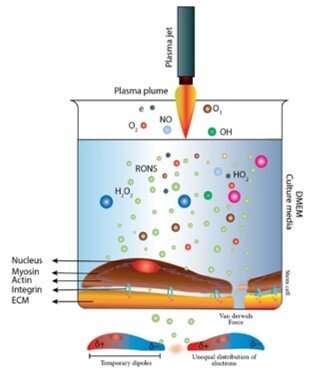
Cold atmospheric plasma can affect cell adhesion with a significant role in stem cell adhesion. In a new study now published in Scientific Reports, Kobra Hajizadeh and a team of researchers in the departments of physics and plasma research at the Islamic Azhad University and the CNRS, France, studied the effect of plasma treatment on human bone marrow mesenchymal stem cell (HBMMSC) adhesion to understand cell differentiation and cell fate.
The research team looked at adhesion modification to explore cell-extracellular matrix interactions and investigated areas between suspended cells to observe enhanced adhesion. The scientists noted increased cell-ECM adhesion during plasma therapy due to the enhanced production of integrin protein. The researchers investigated the role of plasma therapy on van der Waals forces existing between cells at three levels, including plasma induced dipole formation, modifications of the cell culture medium, and cell roughness modifications. The outcomes showed how the support of van der Waals forces (VDWFs) enhanced the process of cell adhesion to provide new insights to plasma therapy at the cellular level.
Influence of cold atmospheric plasma on cell adhesion
Cold atmospheric plasma has a variety of applications in science, with recent therapeutic demonstrations in the clinic. While the presence of reactive oxygen species and reactive nitrogen species (RONS) in the physical environment of the plasma and plasma-activated media is a primary-factor in atmospheric plasma-based therapy, the effects of the electric field to induce cell polarization leading to dipole formation is significant. As a result, plasma can influence van der Waals forces between the cell-cell and the cell-extracellular matrix. The capacity to regulate cell adhesion is important for stem cells to communicate and regulate cell extracellular matrix mechanical communications to maintain cell performance and function. The process of cell adhesion stimulates signaling pathways to activate and enable cell function, leading to physical changes in cell properties, including cell stiffness, mobility and extracellular matrix interactions. The process of plasma-generated cell adhesion can influence van der Waals forces existing between cells, and between the cells of the extracellular matrix, which remains to be studied.
-
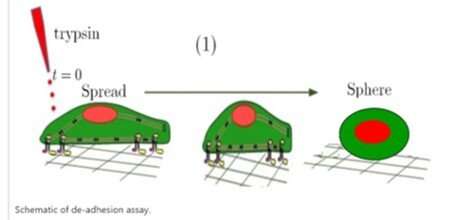
Schematic of de-adhesion assay. Credit: Scientific Reports (2022). DOI: 10.1038/s41598-022-16277-1 -
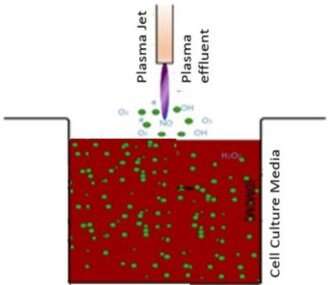
The schematic of plasma-treated cells in cell-suspension. Credit: Scientific Reports (2022). DOI: 10.1038/s41598-022-16277-1
De-adhesion dynamics of cells and other experiments
The scientists developed a de-adhesion test to understand the area of treated and untreated cells. They noted contracted and rounded up cells divided into early delay, fast cell contraction, and saturation frames, where the adhesion strength of the cells treated with higher doses of plasma increased in comparison to non-treated cells. The increased adhesion of the cell-substrate after plasma treatment led to increased expression of the integrin protein and improved activity for cell-substrate adhesion. The team next conducted focal adhesion assays to monitor the impact of cell-adhesion in a dose-dependent manner. When they introduced shear-stress to the media, there was no significant difference in the physical resistance to shear between plasma treated and untreated cell types. When they exposed the first group of cells to either gas or plasma, while exposing the second group to argon treatment alone, they noted increased cell adhesion as a consequence of increased VDW (van der Waals) forces between the cells.
-
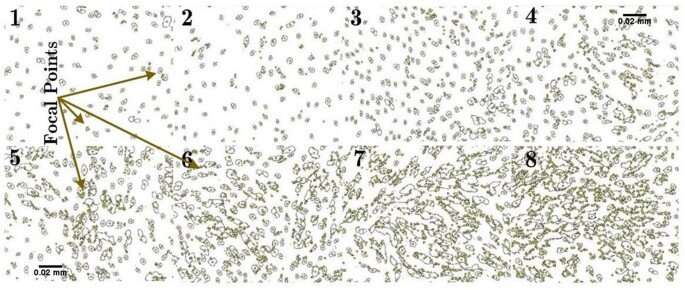
Focal adhesion images for: (1) before treatment and before FA formation, (2) cells treated with Argon (plasma-off) after the formation of FA, and from 3 to 8 the cells were directly exposed to plasma (power = 20 W) for different exposure times: (3) t = 30 s, (4) t = 50 s, (5) t = 70 s, (6) t = 90 s, (7) t = 100 s, (8) t = 120 s. As can be seen in 3–8, more focal points are formed. Increase in FA points depends on the exposure time. Credit: Scientific Reports (2022). DOI: 10.1038/s41598-022-16277-1 -
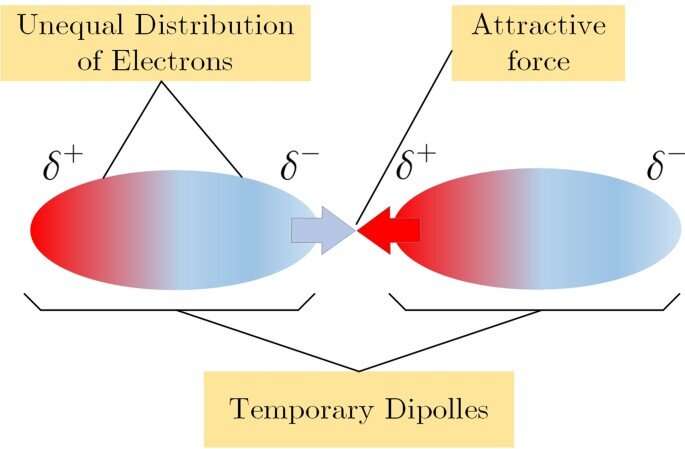
A schematic of the VDW force between temporary dipoles. Credit: Scientific Reports (2022). DOI: 10.1038/s41598-022-16277-1
Outlook
In this way, Kobra Hajizadeh and colleagues examined the influence of the plasma on cell-extracellular matrix adhesion and cell-cell adhesion strengths via de-adhesion and focal adhesion analysis. Increased cell-ECM adhesion was dose-dependent and the time exposure resulted in the increased production and activity of the integrin protein in the medium. The researchers, however, credited rising cell adhesion to increasing van der Waals forces, rather than integrin production and activation. The work took into account the temperature and cell surface roughness effects using atomic force microscopy analysis. The team showed how cell adhesion determined the differentiation and fate of the cells. Based on the study outcomes, the researchers showed how increasing the cell-cell adhesion led to an increase in van der Waals forces. The cells also underwent a change in roughness due to increased van der Waals forces, to further validate the effect of the intercellular force.
More information: Kobra Hajizadeh et al, A van der Waals force-based adhesion study of stem cells exposed to cold atmospheric plasma jets, Scientific Reports (2022). DOI: 10.1038/s41598-022-16277-1
Sui Huang et al, The structural and mechanical complexity of cell-growth control, Nature Cell Biology (2002). DOI: 10.1038/13043
Journal information: Nature Cell Biology , Scientific Reports
© 2022 Science X Network





















